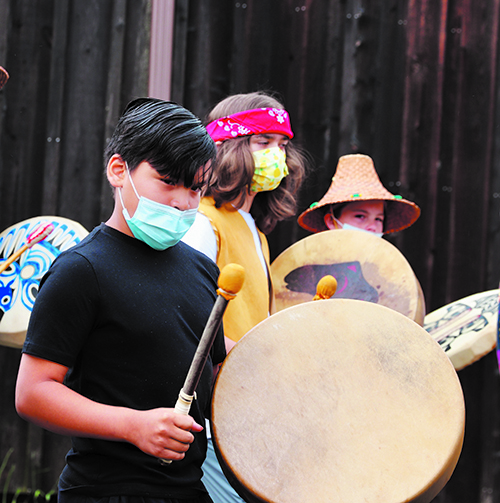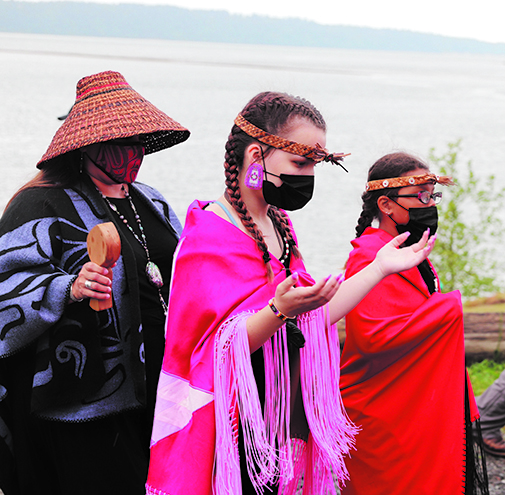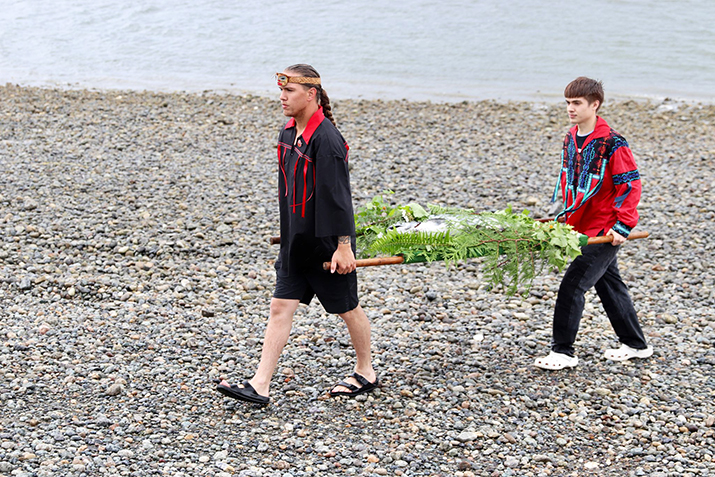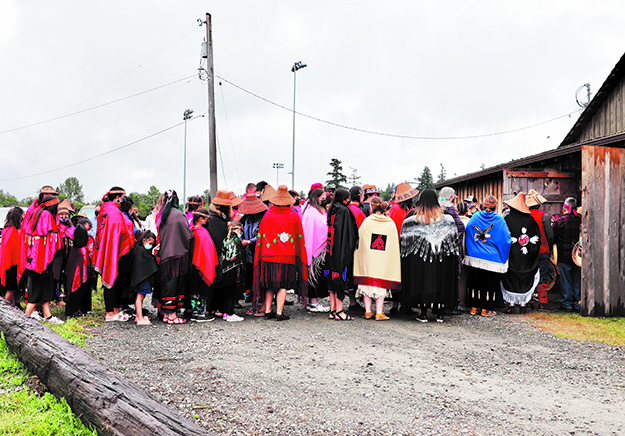
By Kalvin Valdillez, Tulalip News
The salmon are about gone. The forest is all but gone, and other resources are gone because of greed and mistreatment. We don’t know if we’ll ever be able to restore any of these things. So, this is an important story – the Salmon People story.
“The reason to tell this story is because it concerns the environment. And to show that the Snohomish people practiced this for hundreds of years – It tells us something, that’s been told a long time: to conserve and keep things and honor all things because they’re alive. The trees are alive. Everything we eat was alive at some time. And we should give thanks and respect these things as living spirits and show them respect appropriately. And if we don’t, we’re going to lose everything as we know it today.”
The statement above, and subsequent story below, were spoken by the late Bernie ‘Kai Kai’ Gobin nearly thirty years ago, back in 1993. An influential leader of his time, Kai Kai provided this re-telling of the traditional Tulalip story, Salmon Man, for the Marysville School District. The story has been passed on throughout the years since time immemorial, and Kai Kai credited Harriette Shelton Dover for passing it on to the generations following the boarding school era.

The Salmon Man story is important to the tribe’s way of life and is the reason why Tulalip and nearby tribes gather once a year to participate in the Salmon Ceremony at the start of the fishing season. During the Salmon Ceremony, the people pay tribute to the salmon for providing sustenance for the tribal community, while also taking time to traditionally bless the tribal fisherman before they journey out to the Salish waters to harvest salmon for their families.
Due to the cruel assimilation period, the traditional ceremony was outlawed for several decades. That is until 1976 when a handful of Tulalip elders, led by Harriette Shelton Dover, revived the ceremony by recalling what traditionally took place at the special honoring, thereby teaching the upcoming generations the songs, dances and the story of the Salmon Man, also known as the Salmon People story.
Dancers, drummers and singers are currently preparing for Salmon Ceremony which will take place this year on Saturday June 11th, beginning at 10:30 a.m. Leading up to the ceremony, the participants are meeting every week to collectively walk through the Salmon Ceremony start to finish, so the people can build a strong connection to the dances and songs as well as a cultural understanding of the stories about the Salmon People and of the Salmon Ceremony’s revitalization.
Tulalip Chairwoman, Teri Gobin, has participated in the ceremony since it’s revival and extends a warm invite to the entire community, stating that everybody is welcome to come and participate in the weekly Salmon Ceremony practices, which begins at 5:00 p.m. every Thursday at the Tulalip Gathering Hall. The last practice on June 9th, however, will be held at the Tulalip longhouse.

In commemoration of the upcoming Salmon Ceremony, Tulalip News is featuring a weekly mini-series focused on the important cultural and spiritual work that goes into the ceremony year after year. Last week, we explored the significance of passing the tradition onto the next generations and asked a number of participants two questions, when were they introduced to the ceremony and why it was important to them individually. Although we received a variety of great answers, numerous people listed two aspects as reasons to the latter question – practicing the traditions and passing those traditions to the youth.
The revival has already been carried across five decades, and one look into a practice session would show that the Tulalips are doing an incredible job of keeping their traditions alive by passing their teachings to the next generation. In fact, Kamiakin Craig, the grandson of Kai Kai, who shares his Indian name, attends every practice and participates at each Salmon Ceremony every year.
An integral part of the Salmon Ceremony is learning about the Salmon Man story, which is the basis of the ceremony itself and explains a great deal about Tulalip traditions and the importance of preserving their way of life. We’ll let Kai Kai take it from here, as his re-telling of the story is truly fantastic, and if you are like us, hearing and revisiting teachings from elders and elders who’ve passed on, is quite an amazing, eye-opening and enjoyable experience.
Kai Kai:
This is one version of the Salmon Man. You might have heard about the Tulalip Salmon Festival. The Salmon Festival was something that was practiced for hundreds of years by the Snohomish people, the sduhubš people. They are also called ‘the salmon people’. And the story’s extremely important because it links to the present day.
And the story goes that there is a tribe of Salmon People that live under the sea. And each year, they send out scouts to visit their homeland. And the way that the Snohomish people recognize that it’s time for the salmon scouts to be returning to their area is when, in the spring, a butterfly comes out. And the first person to see that butterfly will run, as fast as they can, to tell our chiefs or headmen, or now they are called the chairman. One of the other ways they recognize that the salmon scouts are returning is when the wild spirea tree blooms. The people call it the ironwood tree, and that’s what they use for fish sticks and a lot of other important things, like halibut hooks. It’s a very hard wood. So, when they see either one of these, a tribal member will tell the chairman, and he immediately sends out word to the people and calls them together in the longhouse for a huge feast and celebration to give honor to the visitors that are coming.
The salmon scout will arrive out in the middle of Tulalip Bay there. And the people send out a canoe to meet him. And they put the salmon scout inside the canoe, where a cradle is filled with fern leaves and other soft leaves for a bed for him to come in on and keep him fresh. And he’ll come in by canoe to the cliff right below our longhouse, and there, the whole tribe will be there on the water to greet him. And they’ll walk him in with songs of honor and just greet him in a special way. Then, he’ll be carried on that cradle up into the longhouse, where he’ll be taken around the fires three times and special songs will be sung in his honor. And they will show him the proper respect he needs as the high chief visitor from the Salmon people. And they will go through some different ceremonies there. Then, they will go up into what is now the tribal center and prepare the feast. Before the feast, everyone will share in a tiny piece of the salmon and drink a glass of water with it, a little water.

That’s what is done. And then, everyone sits down and feasts and enjoys the salmon and visits with friends and neighbors.
At the end of feast, they get up. Maybe a speech will be made, and, hopefully, it won’t be too long. Then, a song is sung, and they bring the remains that are left of the salmon back into the longhouse and thank him for coming and again honor him for the chief that he is and take him back down to the canoe, follow him back down there. And they take him back out and lay his remains back where they picked him up, out in the middle of Tulalip Bay. And, if they have treated that chief properly and showed him the proper respect, and treated him like the king he is, he’ll go back to the Salmon People that live under the sea and he’ll tell them that, “Hey, they greatly honored me. They treated me like I should have been treated. They gave me all the recognition I needed.” And he’ll recommend that the Salmon People return back in abundance.

And the reason to tell this story is because it concerns the environment. And to show that the Snohomish people practiced this for hundreds of years. They gave thanks for many things. One of the things was to honor this great chief from the Salmon People and try to protect his environment and have a place for him to come home to. It’s hard to imagine nowadays this visitor going back and telling them, “Hey, things are all right.” Because he has to tell them, “I’ve been up there, and I entered around Admiralty Head, and I started getting a headache.” And he says, “As I traveled further in I become confused and had a hard time finding Tulalip Bay this time.” And he says, “Worse than that. When I went up the Stillaguamish River my home was gone. Where I was born and raised, it’s not there.”
The salmon are about gone. The forest is all but gone, and other resources are gone because of greed and mistreatment. We don’t know if we’ll ever be able to restore any of these things. So, this is an important story – the Salmon People story.